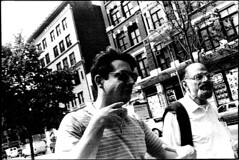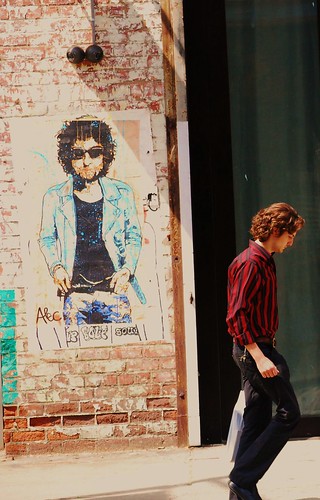 Suzanne Rozdeba Joe Barbosa had been selling records outside of the store.
Suzanne Rozdeba Joe Barbosa had been selling records outside of the store.Earlier today, John Kioussis hauled a turntable and a few remaining crates of records out of an empty, darkened storefront at 33 St. Marks Place. Before locking up the narrow nook that has housed Rockit Scientist Records since 2003, he said he had closed in part because of squabbles with one of his landlords.
Mr. Kioussis let forth a litany of complaints about Amnon Kehati, a co-owner of the building (which is for sale) and of Mark Burger next-door: he had set up tables in front of his store without asking, made unreasonable complaints about garbage bags being left out, and accused the record store of attracting rats.
“The reason we have rats in the building, according to the landlord, is because I have records downstairs and rats are attracted to records,” Mr. Kioussis said as he cleared out his shop. “I wonder what scientist would tell you that Bob Dylan and Sex Pistols records attract rats as opposed to bags of tomatoes and onions all over the floor.” Read more…
 Rosenthal and Ginsberg.
Rosenthal and Ginsberg.Earlier this week, Allen Ginsberg’s secretary of 20 years, Bob Rosenthal, shared memories of his former employer – some of which will be included in a memoir he recently completed, “Straight Around Allen.” Speaking to The Local at Ginsberg’s former apartment on East 12th Street, where the two worked alongside each other for so long, he recalled the great poet’s daily routine, his tastes in literature and music, his mail and telephone communications, and his ways with money. Today, in our second installment, Mr. Rosenthal talks about Ginsberg’s social sphere during his two decades in the so-called poets building. Check back tomorrow for still more from this candid interview.
Allen’s East Village
People would always call Allen and say, “Allen, come to my shangri-la in Hawaii,” and here or there. He would never go. A vacation for Allen was coming back and having nothing to do in the East Village. He would often go to the poetry readings at St. Mark’s. He loved the mushroom barley soup at the Kiev. And The New York Times – he just loved it. He hung around Tompkins Square, wrote a lot of one-line poems about skinheads there. And he was a natural. I think because he always felt free here. Read more…
 Kathy Streem Lynda Crawford, 1971
Kathy Streem Lynda Crawford, 1971Breathless — not just from the late-night climb up 11 flights to the EVO office on East 12th Street, or the astonishing art by the likes of Yossarian, Spain, Little Moon, Joe Schenkman, Brad Holland, R. Crumb, Kim Deitch, Trina Robbins, and Fred Mogubgub, or by Dean Latimer‘s gorgeous prose, or the thrill of reading Ray Schultz, or from the stunning reportage of Jackie Friedrich, Pat Morris, and Claudia Dreifus, or the amazing true life adventures of Coca Crystal (subduing a would-be attacker with a tune on her guitar) and Steve Kraus, or the Krassner interview by Kathy Streem, or the wondrous music reviews by Richard Meltzer and Charlie Frick (and Charlie’s magical layouts), or Tuli’s poetry and songs, Vincent Titus’ fables, Honest Bob Singer’s film writings, Rex Weiner’s off-off Broadway reviews (he was homeless and theaters were warm), Tim Leary’s communiqués from Algeria, A. J. Weberman‘s illuminating investigative portraits, or the vocal harmonies of Steve Heller, Latimer, and Schultz; but also from EVO’s coverage of the major events of the time: efforts to stop the Vietnam War, the Pentagon Papers, the Panther 21 trial, American Indian Movement protests, the murder of George Jackson, the Attica uprising, and Bob Dylan’s 30th birthday party, all produced at high intensity under editor Jaakov Kohn‘s benign leadership.
“EVO is not a tit!” I remember editor Allen Katzman telling several of us when salaries were slashed to the single digits, and then disappeared, during the post–salad days of the early 1970s — my tenure.
I waitressed to pay the rent on my $51-per-month apartment on East Sixth Street and to be able to eat a little more than the nightly fare of free chicken wings and chickpeas at Max’s Kansas City that many subsisted on. The EVO piece I wrote that is most remembered came out of that gig at a deli on Christopher Street when John and Yoko happened in one night and I interpreted their relationship through bits of conversation, body language, and by dissecting leftover pieces of blueberry blintz (A. J. gave me kudos for that one); it was reprinted in the Berkeley Barb and a bunch of other papers too. Read more…
In Larry “Ratso” Sloman’s 1998 book, “Steal This Dream: Abbie Hoffman and the Counter-Culture Revolution in America,” he recounts what happened the day Abbie Hoffman dragged him and Peter Leggieri out of the East Village Other office to witness the Yippie icon’s attack on Wall Street. Mr. Sloman was a lowly EVO intern at the time who credits the paper with giving him his start as a writer. The excerpt is reprinted here with the author’s permission.
Read more…
 A.J. Weberman, Yossarian, Vincent Titus
A.J. Weberman, Yossarian, Vincent TitusHow One-Legged Terry became a member of A.J. Weberman’s circle fades into the mists of memory. Surely, he fit the mold of a Weberman associate with his good humor and dominant, eccentric personality. I met Terry along with a number of people A.J. had acquired from a series of “Dylanology” lectures he had given at Manhattan’s New School for Social Research. This was during a five-month period in 1970 in which I had crossed the country with friends in a (then almost requisite) Volkswagon bus, to spend time with the underground comix community, which by then had assembled in San Francisco.
Terry went by the full moniker of Terry Noble in the United States and Terry Ephraite in Israel, where he had gone to work on a kibbutz after finishing his education. While there, he had been assigned to work atop a hopper that loaded agricultural produce into a machine for processing. His job was to assist in moving the produce from a conveyer that lifted the material to the hopper. After a few days on the job, the platform on which he was standing collapsed, dumping him into the machinery and mangling his left leg. What was left had to be amputated just above the knee. As he remembered his thoughts at the time, they were about the loss of his shoe, one of a pair he had recently bought.
When he sought compensation for his loss, it was revealed that the platform had also collapsed in the recent past, costing another Jewish-American volunteer a leg. Terry surmised that it made more sense to assign an expendable American to the dangerous positions than to fix the underlying fault. Because of the negligence involved, Terry had won a settlement of about $50,000 for his loss. Read more…
In its early issues, The East Village Other began featuring a “Slum Goddess,” a title that was taken from a Fugs song:
When I see her coming down the street,
I’m as happy as I can be,
My beautiful Slum Goddess from Avenue D.
Among the first to be featured was Suze Rotolo, the artist who had been Bob Dylan’s girlfriend. In her memoir, “Freewheelin’ Time: A Memoir of Greenwich Village in the Sixties,” Ms. Rotolo, who died a year ago, of cancer at age 67, tells of the time Walter Bredel photographed her for the feature.
A few weeks later a reporter from the East Village Other, a new local biweekly claiming to be hipper than the Village Voice, asked me to be part of a feature the paper was starting up called “Slum Goddess,” inspired by a song by the Fugs, “Slum Goddess of the Lower East Side.” The feature would be the counterculture’s answer to the Miss America aesthetic of overly made-up and girdled women with beehive hairdos. I thought it was a fine idea and said yes. I was to be the Slum Goddess for December 1965. Read more…
 Tim Schreier
Tim SchreierToday we begin a recurring series of interviews with local experts who will offer their takes on cultural issues, trivia questions and current events concerning the neighborhood.
On Tuesday, American songwriting legend Bob Dylan celebrated his 70th birthday.
In a career that’s spanned 40 years and has had more than its share of mystery, one of the most enduring questions concerns Dylan’s disposition toward the Village and the meaning of the song, “Positively 4th Street.”
Some say the song was meant as a rebuke of all the plastic folkies Dylan met while living in the Village, while others claim it was Dylan’s way reacting to being booed, after leaving his fan-base to go electric at the Newport Folk Festival in 1965, and still others say Dylan was merely talking about the “many 4th streets of his life.” In any case, the song provoked a widespread feeling of individual unease by directing it’s accusations toward a universal “you:”
“You got a lotta nerve
To say you are my friend
When I was down
You just stood there grinning”
The Local East Village contacted Jeff Conklin, co-content Director for East Village Radio to provide his take on the song and Dylan’s relationship to the East Village.
Q.
What’s your interpretation of the song “Positively 4th Street?”
A.
Quite simply jealousy. The song reminds me of a bucket full of crabs, where one crab is inching to get out and all the other crabs are trying to pull him back down. That’s my example of what happened to Dylan, anyway.
“You got a lotta nerve
To say you got a helping hand to lend
You just want to be on
The side that’s winning.”
He had to be angry when he wrote it. It’s a great song.
Read more…









